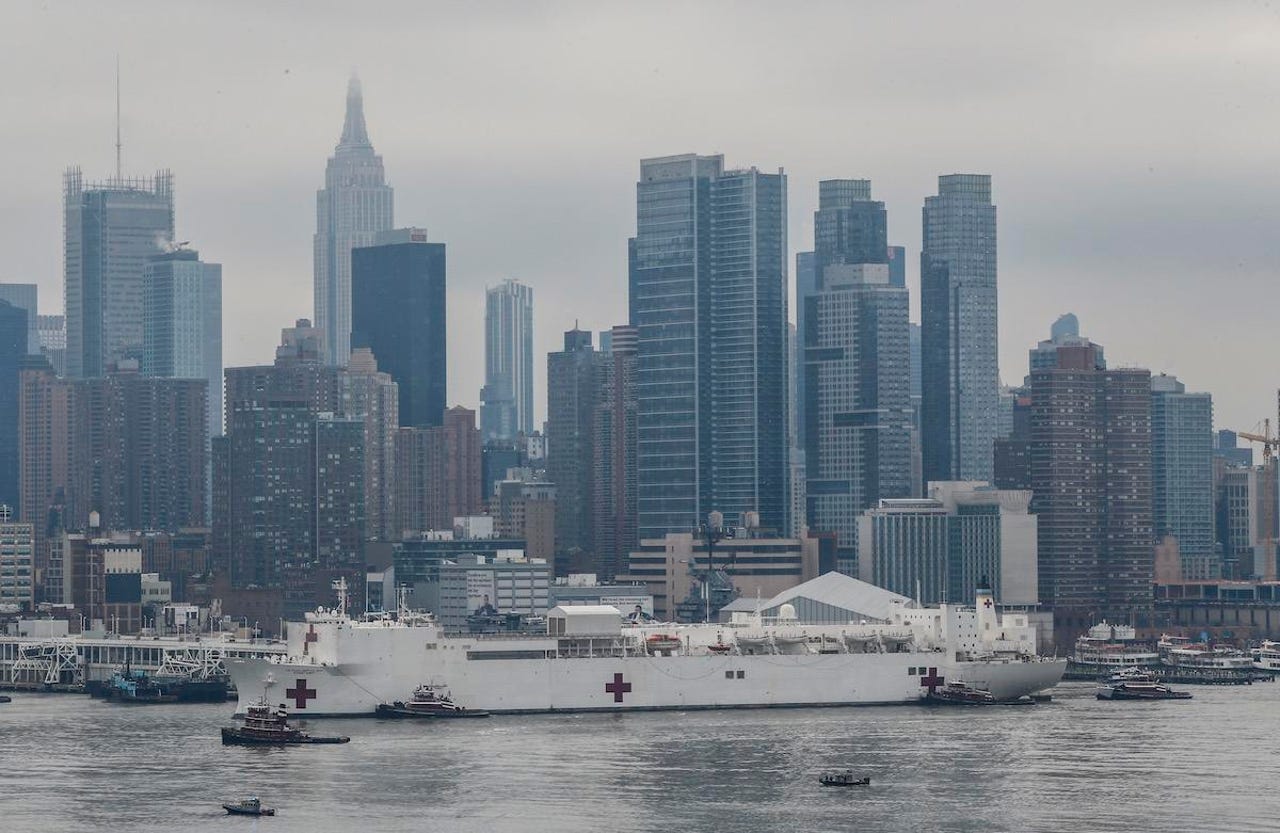Running to the fight: How Verizon brought hospital ship USNS Comfort online to aid NYC COVID-19 response


The USNS Comfort, a massive hospital ship, was sent to New York Harbor in late March to relieve pressure on a healthcare system flooded with a surge of coronavirus patients. However, prepping the area for the Comfort's arrival was no small undertaking. In fact, the harbor itself had to be dredged to accommodate her. At 894-feet, the converted supertanker turned floating naval hospital is certainly a sight to behold. Painted white and emblazoned with red crosses she bears notes of rust from years of service.
Onboard, the ship is specifically engineered to provide medical aid when large-scale disaster strikes. The Comfort houses a dozen operating rooms, 1,000 hospital beds, radiology, and even a pharmacy. Over the years, the USNS Comfort has assisted with humanitarian efforts around the globe. Stateside, the ship has been deployed to help in the wake of domestic emergencies following Hurricane Katrina and 9/11.
The Comfort may have had the equipment to assist in an emergency, however, she would still need the technical infrastructure and support to bring her online for this particular mission. Fortunately, a tech-savvy team similarly well-versed in frontline disaster efforts had been readying the area for her arrival.
"Unfortunately this is not something that we haven't seen in the past. I mean, the Comfort itself is not something that we're used to supporting. That being said, we are used to running to a point of crisis and moving forward to the sound of the guns, if you will, when disaster strikes," said George Riggins, vice president of network engineering at Verizon.
SEE: Coronavirus having major effect on tech industry beyond supply chain delays (free PDF) (TechRepublic)
Dispatching technical support during disasters
Over the years, Verizon teams have also been deployed to the frontlines with numerous domestic emergencies. This includes providing aid following the Oklahoma City bombing and, most recently, supporting technical capabilities in Nashville after a deadly tornado ravaged the city in early March. Verizon disaster teams have also played a critical frontline role in the fight against the spread of the coronavirus.
"We've been turning up capacity for pop-up hospitals, pop-up COVID testing, staging areas for first responders. We've deployed fiber, we've deployed radio access networks, 4G LTE service, satellite backhaul. And that's just in the Northeast region," said Riggins.
Technical infrastructure and improvised setups
As one would imagine, there's no clear cut technical blueprint for an emergency strategy. Each of these impromptu setups (often situated in the middle of a disaster zone) will require its own approach and remedy. This means working with what's available and designing the infrastructure with these assets to meet the demands on the ground.
"In this case we were fortunate enough to have the fiber available at the location. Unlike some other cases where we've had things like pop-up testing locations, you know, pop-up COVID testing locations, pop-up hospitals, things like that where we've actually had to string fiber from one spot to another," said Riggins.
SEE: Coronavirus: Business and technology in a pandemic
Safety and logistical snags
The ship may have had the fiber in place, but this project had its own set of unique challenges. As we learned in our interview, the building the government had originally pinpointed to host the circuit termination was abandoned and deemed untenable requiring the team to relocate the setup to another pier. There was also another layer of safety and security tied into a mission that involved sending humans into ground zero of the U.S. coronavirus outbreak.
"We actually had logisticians the night before breaking out personal protective equipment and shipping it overnight," said Riggins.
Once the team had bypassed the logistical curveballs and taken appropriate steps to mitigate the risks for those on the ground, they could then begin to lay the technical groundwork to bring the Comfort online.
"We did deploy a network interface device. We turned up a one gigabit per second UNI, a user network interface to count up to the ship there. And then off of that we provisioned to ethernet virtual circuits, EVCs, to provide dual redundancy," said Riggins.
NYC Coronavirus peak and plateau
Needless to say, this massive effort required calculated coordination to accomplish these objectives in a rather narrow timeframe. Over the next few weeks, the pandemic would peak in New York, and soon thereafter Governor Cuomo said the city no longer needed the Comfort's services. She has since unmoored from Pier 90 and left the harbor awaiting her next humanitarian assignment. The Verizon representatives we spoke with reiterated a similar sense of preparedness and duty moving toward that next mission wherever that may be.
"Verizon runs to a crisis. At the scene of a crisis there's a whole ecosystem of people and services and organizations that are trying to help and what Verizon brings to the crisis empowers the information sharing and the communications necessary to bring the relief to whatever situation we're running to," said Fred Ferares, director of department of defense sales at Verizon.